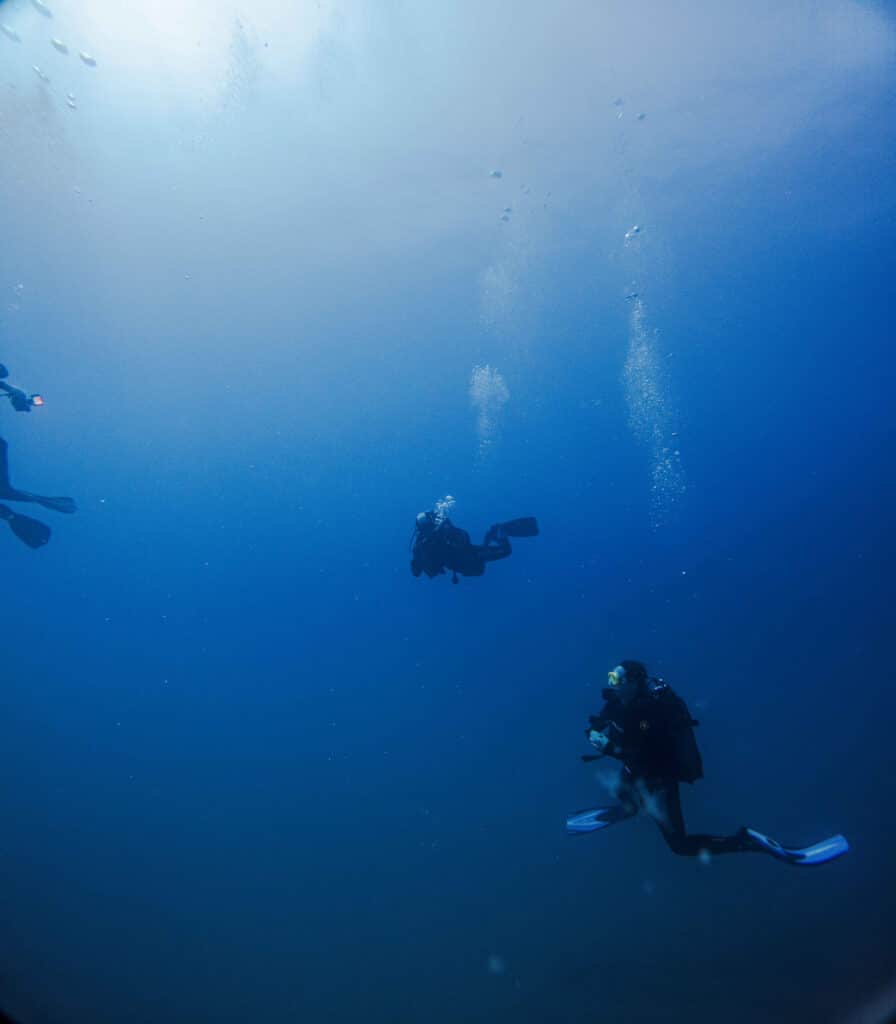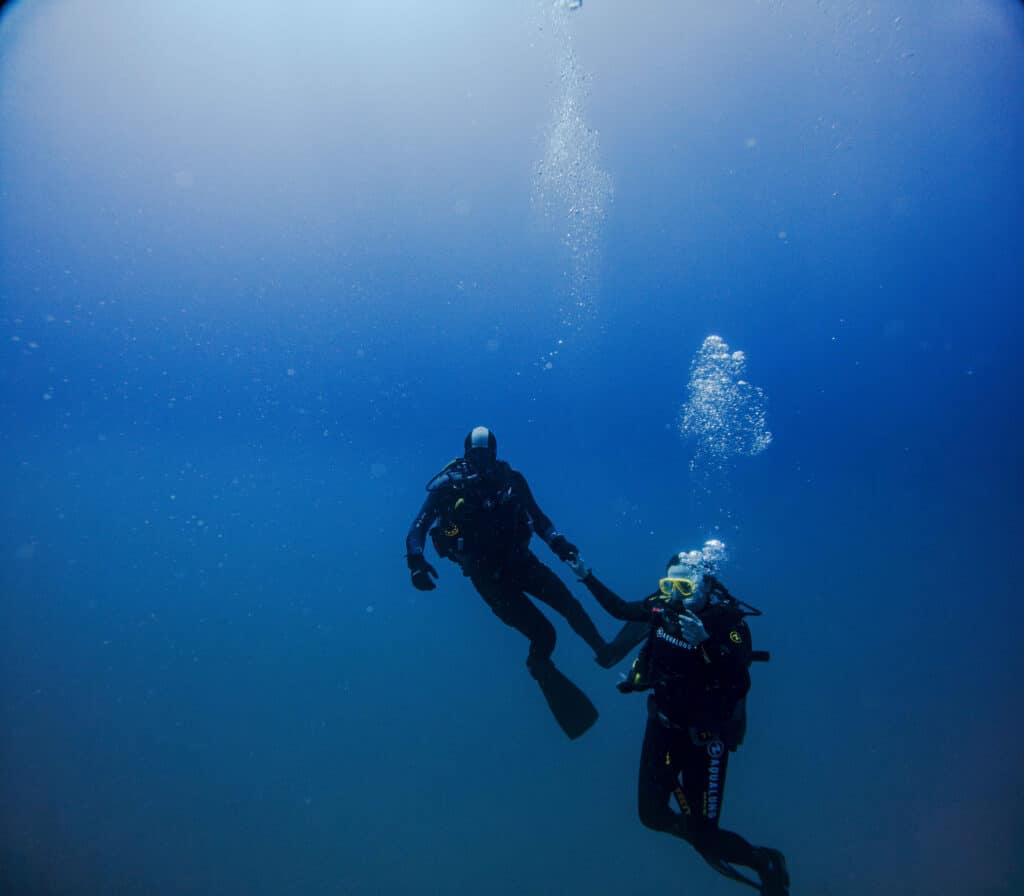Whether you are just starting out or have been diving for a few dives, understanding depth limits, their risks and regulations will allow you to dive with greater safety and confidence. In this regard, a common but important question is how deep is diving considered deep?
In this article you will find the answer and everything you need to know about this fascinating form of recreational diving. Whether you are a beginner, a certified diver or just curious about this exciting underwater world, here we explain what deep diving is, what its legal and physical limits are, and what you need to know before diving deeper.
What is considered deep diving?
In the recreational diving world, a deep dive, or deep dive, is considered to be any descent that exceeds 18 meters (60 feet) in depth. However, some certifying agencies may consider deep diving as deep as 20 or 25 meters. In any case, beyond that depth, more knowledge, specific planning and additional dive training are required.
It is important to clarify that deep diving is not the same as a conventional dive. It requires:
- Specialized training to manage the risks of greater depths.
- Adapted equipment, such as alternative gas mixtures (Nitrox or Trimix) and additional safety systems.
- Advanced knowledge of nitrogen narcosis, decompression and air consumption.
In Dive Academy Santa Pola we have experienced instructors, training for all levels and a privileged environment such as the coast of Tabarca. We know well what deep diving involves, and we explain everything in a clear and safe way.

Depth levels in diving
Diving is divided into different categories according to depth, each with its own specific characteristics and requirements. Knowing these levels is essential to plan safe dives and enjoy the underwater experience to the fullest:
- Shallow Diving (0-12 meters / 0-40 feet): Ideal for beginners and snorkelers, dives for basic courses or diving with children.
- Intermediate Dive (12-18 meters / 40-60 feet): Standard depth for recreational diving.
- Deep Diving (18-40 meters / 60-130 feet): Maximum limit for Open Water certified recreational divers. Up to 40 meters with specific deep diving courses.
- Technical Diving (40+ meters / 130+ feet): Requires specialized certification and different equipment.
How deep can a diver dive?
Although many divers enjoy exploring reefs and marine life at moderate depths, others wish to go deeper. However, one must keep in mind, the different modalities of diving. For example:
- The maximum internationally accepted scuba diving depth authorized for recreational diving is 40 meters (130 feet).
- Technical diving, can exceed 100 meters, using gas mixtures such as trimix. The greatest maximum depth reached to date is 332.35 meters (1,090.38 feet), by Ahmed Gabr in the Red Sea in September 2014.
- In the practice of Apnea diving, the depth record for diving without equipment (free apnea) exceeds 120 meters (400 feet), achieved by Arnaud Jerald in 2023.
Diving limits under Spanish law in 2025
In terms of recreational diving, Spanish legislation, in Royal Decree 550/2020, (which determines the safety conditions for diving activities), establishes certain depth limits depending on the age and certification of the diver:
By age
- 8-14 years: Maximum 6 meters (only in confined water/pools)
- 14-18 years: Maximum 18 meters (with instructor)
- +18 years: Up to 40 meters (according to certification)
By certification level
- Diving baptism: 6 meters (with instructor)
- Open Water Diver: 18 meters
- Advanced Open Water: 30 meters
- Deep Diver (specialty): 40 meters (recreational maximum limit)
Additional restrictions
- Prohibited to exceed 40 meters in any recreational modality.
- In addition, the use of the compressor, the frequency of dives and the minimum equipment required are regulated.
Exceptions
- Lower limits may apply in protected areas (marine reserves)
- Dive centers may establish more conservative restrictions of their own.

Factors limiting diving depth
Before attempting a deep dive, you should understand what variables directly influence depth limits. It’s not just about experience or equipment, but how your body reacts to your environment under pressure.
Water Pressure
For every 10 meters of depth, the pressure increases by one atmosphere. This affects both the body and the equipment. The compression of the air in the lungs and the increased density of the gas breathed require greater breathing efficiency and effort control.
Narcosis effects
Nitrogen narcosis can appear from 30 meters. It causes a feeling of intoxication that reduces the capacity for reaction and judgment. It is one of the major dangers of deep diving and one of the reasons for limiting it without proper training.
Temperature
The deeper you go, the lower the temperature. A sudden change can lead to hypothermia if you do not have the right suit. That is why wetsuits (or Hucticos) for diving are usually used for deep dives.
Oxygen
At high pressures, oxygen can become toxic. Therefore, it is not recommended to exceed 1.6 ATA (absolute atmosphere) of oxygen partial pressure. In deep diving, mixtures such as Nitrox or Trimix are used to avoid this effect.
Decompression complications
One of the main concerns when increasing depth is the risk of decompression sickness. It is vital to control bottom time, respect safety stops and ascend slowly.
Considerations and tips for deep dives
Before venturing out on a deep dive, keep these recommendations in mind:
- It is not enough to be a certified diver. To get to 30 or 40 meters safely, you need a specialty course.
- Air consumption, bottom times and decompression stops must be calculated.
- Use dive computers, wet suit if necessary, flashlight and a marker buoy.
- Never dive alone, deep dives should always be done in pairs or groups.
- Control your physical and mental state, avoid diving if you have a cold, are tired or have doubts.
Why learn deep diving with Dive Academy Santa Pola?
In Dive Academy Santa Pola we help you to get trained in a safe way, with professional instructors, small groups and the best location in front of the island of Tabarca. If you were wondering how many meters deep diving is considered, now you know, it starts from 18 meters, with a limit of 40 meters for recreational diving.
Contact us today and book your diving adventure in Alicante!

